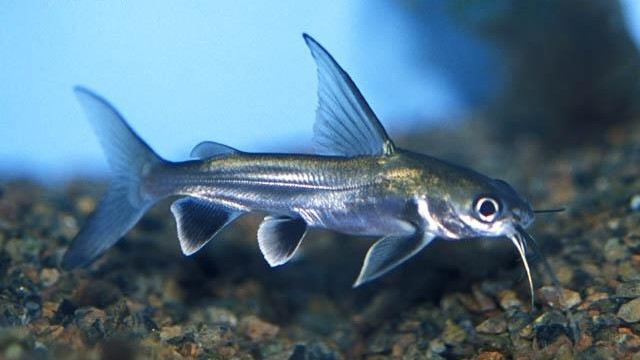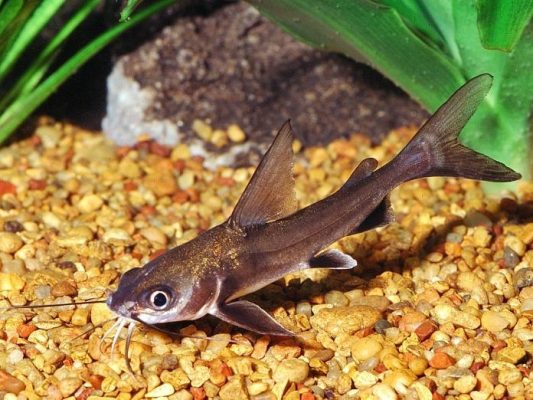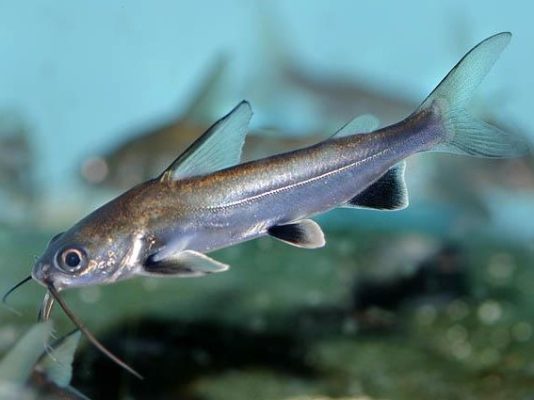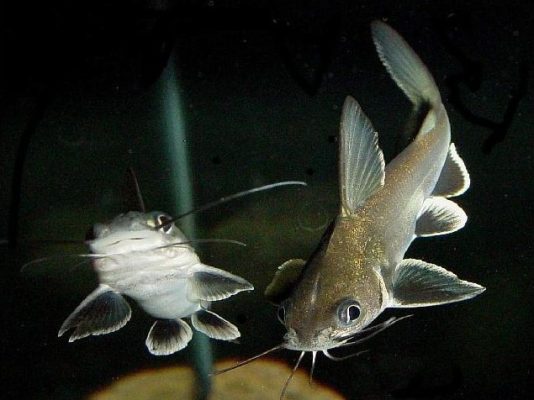Colombian Shark Catfish

Table of Contents
- Introduction
- Taxonomy and Classification
- Habitat and Distribution
- Behavior and Reproduction
- Ecological Role and Importance
- Conclusion
Introduction
The Colombian Shark Catfish, scientifically known as Ariopsis seemanni, is a captivating species that has gained significant popularity among aquarium enthusiasts. With its unique characteristics and behaviors, this species has become a sought-after addition to many aquariums around the world.
In its native habitat of Colombia, the Colombian Shark Catfish plays a crucial role in maintaining the balance of the ecosystem. This species contributes to the food web by occupying a position as both predator and prey. As an opportunistic feeder, it helps regulate the population of smaller fish and invertebrates, preventing overpopulation and promoting ecosystem stability.
Furthermore, the Colombian Shark Catfish exhibits remarkable adaptations that make it a valuable species. Its elongated body and long dorsal fin allow it to navigate through various aquatic environments, while its barbels help it locate food sources. These adaptations enable the Colombian Shark Catfish to thrive in its natural habitat and fulfill its ecological role.
The goal of this article is to provide a comprehensive guide to the Colombian Shark Catfish, focusing on its physical characteristics, habitat, behavior, and conservation status. By understanding these aspects of the species, we can appreciate its unique qualities and contribute to its conservation. It is essential to raise awareness about the Colombian Shark Catfish to ensure its long-term survival and the preservation of its ecosystem.
In the following sections, we will delve into the taxonomy and classification of Ariopsis seemanni, explore its physical characteristics, discuss its habitat and distribution, examine its behavior and reproduction, analyze its ecological role and importance, address its conservation status and threats, evaluate human interaction and utilization, review research and scientific studies, and conclude with a call to action for further conservation efforts and research on this remarkable species.
Taxonomy and Classification
Description of the taxonomic classification of Ariopsis seemanni
The Colombian Shark Catfish, scientifically known as Ariopsis seemanni, belongs to the family Ariidae, which is a group of catfish commonly referred to as sea catfish or shark catfish. Within the Ariidae family, Ariopsis is the genus to which the Colombian Shark Catfish belongs. The species name, seemanni, is derived from the German naturalist Carl Seemann, who first described this species in 1861.
The Colombian Shark Catfish is taxonomically related to other catfish species within the Ariidae family, such as Ariopsis felis and Ariopsis guatemalensis. These species share similar morphological characteristics, including their elongated bodies, barbels, and dorsal fins.
Explanation of the species’ common names and their origins
The Colombian Shark Catfish is commonly referred to by its scientific name, Ariopsis seemanni, as well as its common name, Colombian Shark Catfish. The common name “Colombian Shark Catfish” reflects its native habitat in Colombia, where it is found in various river systems and coastal areas.
The origins of common names can often be traced back to cultural or historical references. In the case of the Colombian Shark Catfish, its common name highlights its resemblance to sharks in terms of its appearance and behavior. The term “shark” is used to describe its sleek and streamlined body shape, as well as its predatory nature.
Additionally, the common name “catfish” is used to emphasize its taxonomic classification within the catfish family. The term “catfish” is commonly associated with bottom-dwelling freshwater fish known for their barbels and whisker-like sensory organs. Although the Colombian Shark Catfish is primarily found in brackish water, it shares some physical characteristics with freshwater catfish, leading to the use of the term “catfish” in its common name.
It is worth noting that common names can vary across different regions and languages. In some areas, the Colombian Shark Catfish may be referred to by other local names, which further highlight its cultural significance and regional associations.
Overall, the common names of the Colombian Shark Catfish, including “Colombian Shark Catfish,” reflect its physical attributes, taxonomic classification, and geographical distribution, providing a convenient and descriptive way to refer to this fascinating species.
Physical Characteristics
Size and Weight Range of Colombian Shark Catfish
The Colombian Shark Catfish, scientifically known as Ariopsis seemanni, is a fascinating species with a wide range of sizes and weights. On average, adult Colombian Shark Catfish can reach a size of 12 to 18 inches (30 to 45 centimeters) in length. However, there have been reports of individuals growing up to 24 inches (60 centimeters) in exceptional cases. The weight of these catfish can vary depending on various factors such as age, diet, and environmental conditions.
It is important to note that the size of the Colombian Shark Catfish can be influenced by its age. Juvenile individuals are typically smaller, measuring around 4 to 6 inches (10 to 15 centimeters) in length. As they mature, they undergo significant growth, reaching their maximum size in adulthood.
Description of the Body Structure, Including Shape, Color, and Markings
The Colombian Shark Catfish possesses a unique and captivating physical appearance. Its body is elongated and streamlined, resembling the shape of a shark, which is why it is commonly referred to as the Colombian Shark Catfish. The body is covered in smooth, scaleless skin, giving it a sleek and slippery texture.
In terms of coloration, the Colombian Shark Catfish exhibits a dark gray to blackish hue on its dorsal side, fading to a lighter shade on its ventral side. This coloration helps the catfish blend into its natural environment, providing camouflage and protection from predators. Additionally, some individuals may display faint vertical stripes or spots along their body, adding to their overall aesthetic appeal.
Discussion on the Unique Features and Adaptations of Ariopsis seemanni
One of the most distinctive features of the Colombian Shark Catfish is its long dorsal fin, which extends along the entire length of its back. This fin serves multiple purposes, including stability during swimming and maneuvering through its habitat. It also aids in maintaining balance and agility, allowing the catfish to navigate through different water currents and environments.
Another notable adaptation of the Colombian Shark Catfish is the presence of barbels around its mouth. These whisker-like appendages are highly sensitive to touch and help the catfish locate food and navigate its surroundings. The barbels contain numerous taste buds, allowing the catfish to detect and identify potential prey items or food sources.
Furthermore, the Colombian Shark Catfish possesses a unique respiratory adaptation known as the labyrinth organ. This specialized organ enables the catfish to extract oxygen from the air, allowing it to survive in oxygen-deprived or stagnant waters. This adaptation gives the Colombian Shark Catfish a competitive advantage in habitats where other fish species may struggle to obtain sufficient oxygen.
Overall, the physical characteristics and adaptations of the Colombian Shark Catfish contribute to its survival and behavior in its native habitat. Its streamlined body shape and coloration provide effective camouflage, while the long dorsal fin and barbels enhance its swimming abilities and foraging efficiency. The presence of the labyrinth organ allows the catfish to thrive in various aquatic environments, ensuring its resilience and adaptability.
Habitat and Distribution
Overview of the natural habitat preferences of Colombian shark catfish
The Colombian Shark Catfish, Ariopsis seemanni, is a species that exhibits specific habitat preferences. It is primarily found in the freshwater and brackish water ecosystems of South America, particularly in Colombia. This species inhabits rivers, streams, and estuaries, where it can find the ideal conditions for its survival.
In terms of water temperature, the Colombian Shark Catfish prefers a range between 22°C to 28°C (72°F to 82°F). This temperature range provides optimal conditions for its physiological functions and overall well-being. Additionally, this species is capable of adapting to different water conditions, including variations in temperature, salinity, and pH levels.
Vegetation plays a crucial role in the habitat preferences of the Colombian Shark Catfish. It is commonly found in areas with abundant aquatic vegetation, such as submerged plants and floating vegetation. These plants provide important shelter and hiding places for the catfish, as well as serve as a source of food and protection for its prey.
Geographical distribution and range of Ariopsis seemanni
The Colombian Shark Catfish is predominantly distributed in the freshwater and brackish water systems of South America. It is commonly found in Colombia, particularly in the Magdalena and Cauca River basins. These river systems provide the ideal habitat conditions for the species, with suitable water temperature, vegetation, and prey availability.
In addition to Colombia, the Colombian Shark Catfish has also been reported in other countries in South America, including Venezuela and Ecuador. However, its presence in these countries may be less common compared to its abundance in Colombia.
Within its geographical range, the Colombian Shark Catfish tends to inhabit areas with slow-moving or stagnant waters. It can be found in both clear and turbid water conditions, as it has the ability to adapt to different water qualities and levels of sedimentation.
Factors influencing the species’ distribution and abundance
The distribution and abundance of the Colombian Shark Catfish are influenced by various environmental factors. Habitat loss, resulting from deforestation, urbanization, and agricultural activities, poses a significant threat to this species. The destruction of its natural habitat reduces the availability of suitable areas for reproduction, feeding, and shelter, ultimately impacting its population size.
Pollution, particularly water pollution caused by industrial and agricultural runoff, also affects the Colombian Shark Catfish. High levels of pollutants, such as heavy metals and pesticides, can have detrimental effects on the health and survival of this species. It can lead to physiological stress, reproductive abnormalities, and compromised immune systems, ultimately reducing its population numbers.
Climate change is another factor that influences the distribution and abundance of the Colombian Shark Catfish. Changes in temperature and precipitation patterns can disrupt the natural balance of aquatic ecosystems, affecting the availability of food and altering the reproductive cycles of the species. Additionally, rising sea levels and increased storm events can result in saltwater intrusion into freshwater habitats, which may negatively impact the Colombian Shark Catfish’s ability to thrive.
It is crucial to address these factors and implement conservation measures to ensure the long-term survival of the Colombian Shark Catfish. Protecting its natural habitat, reducing pollution, and mitigating the impacts of climate change are essential steps in preserving this species and maintaining the ecological balance of its native ecosystems.
Behavior and Reproduction
Feeding Habits and Diet of Ariopsis seemanni
The Colombian Shark Catfish, Ariopsis seemanni, is renowned for its opportunistic predatory nature when it comes to feeding. This species exhibits a diverse diet, consuming a variety of food sources to meet its nutritional needs. In their natural habitat, Colombian Shark Catfish primarily feed on smaller fish, crustaceans, and invertebrates. They are also known to scavenge on decaying organic matter and consume plant material.
Studies have shown that Colombian Shark Catfish have a preference for live prey, actively hunting and capturing smaller fish in their environment. They use their sharp teeth and strong jaws to grasp and consume their prey efficiently. This predatory behavior is an essential adaptation that allows them to thrive in their ecosystem.
In addition to live prey, Colombian Shark Catfish readily accept commercially available catfish pellets in captivity. These pellets provide a balanced diet and are often formulated to meet the nutritional requirements of catfish species. It is important to note that while pellets can be a convenient and readily available food source, it is still beneficial to supplement their diet with live or frozen foods to mimic their natural feeding behaviors.
Reproductive Behavior and Strategies
The reproductive behavior of Ariopsis seemanni is an intriguing aspect of their biology. In their natural habitat, Colombian Shark Catfish engage in courtship rituals to initiate the breeding process. Males typically exhibit territorial behavior, establishing and defending a suitable area for courtship and spawning.
During courtship, male Colombian Shark Catfish will actively pursue and court females, displaying various behaviors such as fin flaring and body movements. Once a female is receptive, the male will lead her to a suitable spawning site. Spawning usually occurs in shallow waters with dense vegetation, where the female releases her eggs and the male fertilizes them externally.
It is worth noting that breeding Colombian Shark Catfish in captivity can be challenging and less common compared to other species. The specific environmental conditions required for successful reproduction, including water parameters and suitable spawning sites, are often difficult to replicate in an aquarium setting. However, with proper care and attention to their specific needs, successful breeding can be achieved.
Social Behavior and Interactions within the Species
Colombian Shark Catfish exhibit interesting social dynamics and interactions within their species. They are generally peaceful and can be kept in groups, although territorial behaviors may arise, especially during breeding periods. In captivity, it is important to provide ample space and hiding spots to reduce potential conflicts among individuals.
In their natural habitat, Colombian Shark Catfish are known to form loose aggregations or schools, particularly during migration or feeding activities. These aggregations provide protection against predators and increase their chances of finding food. Within these schools, a hierarchy may develop, with dominant individuals occupying preferred feeding or resting areas.
When interacting with other fish species, Colombian Shark Catfish are generally tolerant and non-aggressive. However, caution should be exercised when keeping them with smaller fish species that may be seen as potential prey. It is recommended to choose tank mates that are similar in size and have compatible temperaments to ensure a harmonious community aquarium.
Overall, the behavior and reproduction of Ariopsis seemanni contribute to their ecological success and adaptability. Understanding these aspects of their biology is crucial for their conservation and proper care in aquarium settings.
Ecological Role and Importance
Analysis of the Ecological Niche Occupied by Colombian Shark Catfish
The Colombian Shark Catfish, Ariopsis seemanni, plays a vital role in its ecosystem by occupying a unique ecological niche. As an opportunistic predator, it serves as an important link in the food chain, regulating the population of its prey species and contributing to the overall balance of the ecosystem.
Being a carnivorous species, the Colombian Shark Catfish primarily feeds on smaller fish, crustaceans, and invertebrates. Its predatory behavior helps control the population of these prey species, preventing them from becoming overly abundant and potentially disrupting the ecosystem. By regulating prey populations, the Colombian Shark Catfish helps maintain the stability and biodiversity of its habitat.
Discussion on the Species’ Interactions with Other Organisms in Its Ecosystem
The Colombian Shark Catfish interacts with various organisms within its ecosystem, establishing both symbiotic and mutualistic relationships. One notable interaction is its relationship with certain species of cleaner fish. These cleaner fish, such as cleaner wrasses, feed on parasites and dead skin of larger fish, including the Colombian Shark Catfish. In return, the catfish benefits from the removal of parasites, which promotes its overall health and well-being.
Additionally, the Colombian Shark Catfish plays a role in nutrient cycling within its ecosystem. As a predator, it consumes prey species, which then become a source of nutrients. Through its feeding habits, the catfish contributes to the transfer of energy and nutrients within the food web, supporting the growth and survival of other organisms in the ecosystem.
Examination of the Impact of Ariopsis seemanni on the Food Web and Ecosystem Stability
The feeding habits and behavior of the Colombian Shark Catfish have significant ecological consequences. Its presence in the food web helps maintain a balanced ecosystem by controlling the population of its prey species. Without this regulation, prey species could experience population explosions, leading to competition for resources and potential ecosystem imbalances.
Furthermore, the Colombian Shark Catfish’s role as a predator contributes to the overall stability of the ecosystem. By keeping prey populations in check, it helps prevent the overconsumption of resources and the subsequent decline of other species. This balance is crucial for the long-term sustainability and health of the ecosystem as a whole.
The absence of the Colombian Shark Catfish can have detrimental effects on the ecosystem. Without its predatory influence, prey populations may increase unchecked, leading to resource depletion and potential cascading effects throughout the food web. Understanding and conserving the Colombian Shark Catfish is therefore crucial for maintaining the ecological balance and stability of its habitat.
Conclusion
In conclusion, this article has provided a comprehensive guide to the Colombian Shark Catfish (Ariopsis seemanni), highlighting its physical characteristics, habitat, behavior, and conservation status.
Throughout the article, we have explored the fascinating world of the Colombian Shark Catfish, also known as Ariopsis seemanni, and its significance in the Colombian ecosystem. This species has captured the attention of aquarium enthusiasts worldwide, thanks to its unique features and adaptability.
The Colombian Shark Catfish plays a vital role in its native habitat, contributing to the food web and ecosystem stability. Its opportunistic predatory nature and ability to adapt to different water conditions make it a valuable species. Additionally, its long dorsal fin and barbels are distinct characteristics that aid in its survival and behavior.
Understanding the Colombian Shark Catfish’s preferred habitat conditions, such as brackish water and specific temperature and pH ranges, is crucial for its conservation. This species is found primarily in South America, particularly in Colombia, but its distribution is influenced by environmental factors such as habitat loss, pollution, and climate change.
The Colombian Shark Catfish exhibits interesting feeding habits, consuming smaller fish and catfish pellets. Breeding in captivity is challenging and less common, making it essential to protect its natural habitats for successful reproduction. The social dynamics of this species, including interactions with conspecifics and other fish species, reveal intriguing territorial and hierarchical behaviors.
In terms of its ecological role, the Colombian Shark Catfish occupies a significant niche in the ecosystem, contributing to the food chain and nutrient cycling. Its interactions with other organisms, such as fish species, plants, and invertebrates, demonstrate the complexity of its relationships within its habitat.
Unfortunately, the conservation status of the Colombian Shark Catfish is a cause for concern. Habitat destruction, overfishing, and pollution pose significant threats to its population. However, there are ongoing conservation efforts and initiatives aimed at protecting this species and its habitat. These include research projects, community involvement, and policy changes that support its conservation.
Human interaction with the Colombian Shark Catfish has historical and current uses, ranging from traditional uses by local communities to its economic importance in the fishing industry. Sustainable practices and responsible management are essential for the long-term viability of this species, and regulations and guidelines are in place to ensure its protection.
Scientific studies have played a crucial role in understanding and conserving the Colombian Shark Catfish. Notable research has provided insights into its biology, ecology, and population dynamics. However, there are still gaps in our knowledge, particularly in areas such as reproductive biology and habitat requirements, which require further research.
In conclusion, the Colombian Shark Catfish, Ariopsis seemanni, is a species of great importance in the Colombian ecosystem. Its physical characteristics, habitat preferences, behavior, and conservation status have been thoroughly explored in this article. It is crucial to recognize the significance of this species in maintaining ecosystem balance and biodiversity.
To ensure the long-term survival of the Colombian Shark Catfish, it is imperative to support conservation initiatives and research projects focused on this species. By doing so, we can contribute to the protection and understanding of this fascinating species and promote its conservation for future generations.



